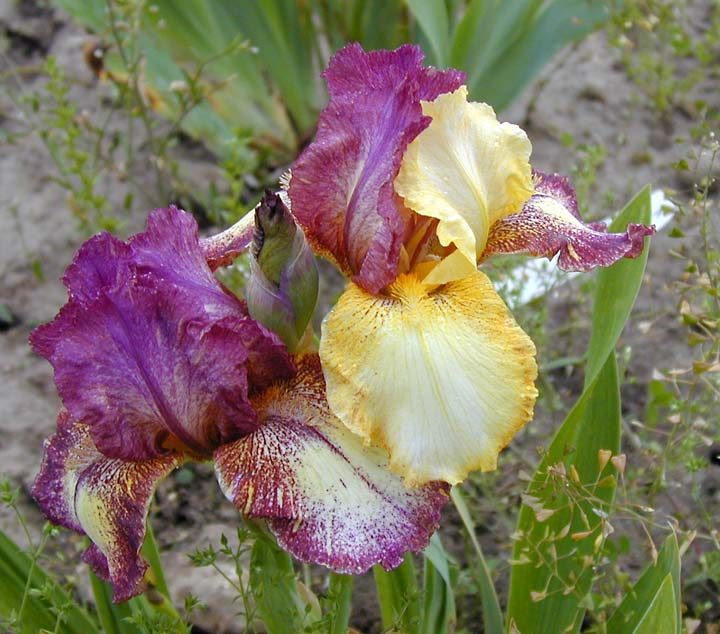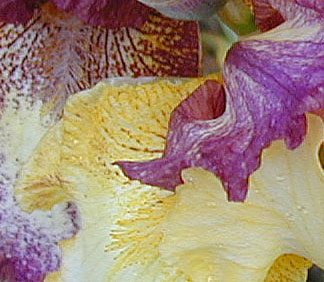This is a public-interest archive. Personal data is pseudonymized and retained under
GDPR Article 89.
RE: Yellow plicatas and Timewarp
- Subject: [PHOTO] [iris-photos] RE: Yellow plicatas and Timewarp
- From: i*@netscape.net
- Date: Fri, 21 Jan 2005 16:01:45 -0500
You do have yellow , pink, blue etc amoenas even if the carotenoid and
anthocyanin pigments are controlled by separate genes and a yellow amoena
will not afect the distribution of the anthocyanin pigment. Look at the two
attached pictures of a chimera of Summer camp. The exact same distribution of
the anthocyanin and the carotene pigments are obvious when the anthocyanin is
removed. the original idea was that plicatas are a pattern of the anthocyanin
and that thus you couldn't have carotenoid plicatas as the plicata gene
didn't control the cartenoid pigments. A lot of the original "yellow
plicatas" were a plicata pattern of anthocyanin on a yellow ground. This
basically was called a misuse of the term and I agree fully with this. Thus
the terminology was very incorrect used this was and we now call these
plicata on a yellow ground. Now when people say yellow plicata they refer to
a stitching of yellow in a plicata pattern on a white ground. When Light
Beam (Blyth 1985) was first introduced Barry called it a yellow plicata. It
was from Broadway X Beverly Sills. He got called to task for using such a
term. Broadway is a plicata with intense , unmarked yellow standards and
falls with red plicata markings around the falls which are white in the
centre. A close look shows that there basically is a yellow rim around the
standards and the anthocyanin is on top of this, not what I would call a red
on white plicata but a plicata on a Joyce Terry ground. Beverly Sills is a
pink but it and its parent Vanity throw lots of plicatas. Either one or both
could be a plicata with the anthocyanin removed by one of the anthocyanin
removal genes (recessive or dominant) and with BS I suspect "I". I used LB in
a plicata cross and got all plicata offspring. Barry also has done this and
has gotten the same result. Jean Witt had written an article (I'd have to
look up the reference) where she was a heretic (my term) and presented an
argument for there being yellow plicatas with the yellow pigment distributed
in a plicata pattern just like the anthocyanin is.
In the cross of mine with light beam I got some seedlings with a purple
plicata stitching on a Joyce terry pattern. The colour of the stitching is
red when it is on the yellow ground and violet-blue where it is on the white
ground on the falls. There also was one seedling with yellow stitching in
exactly the same pattern as in a plicata. Dots and veins and not solid as in
a JT pattern.
Facts are facts, theories try to explain facts, if they don't then we need
another explanation. I have accepted these facts to mean that we can have
carotenoid pigment distributed exactly like anthocyanin apparently controlled
by the same factor. You don't check out something that you don't believe in
its existence so this hasn't been researched as it doesn’t exist, right?
Well my first thoughts were that perhaps the yellow was a flavanoid so I
checked this out. That is not the case, it really is an oil based yellow
pigment, not water based. Currently I'm trying to find out if we can call on
a structural explanation. That is a difference in the cell structure that
somehow prevents any pigment from being present. It seems to be related to
the original genes from Iris variegata where we can and do have both water
based and oil based pigments distributed exactly the same way, 100 percent
matching. You can't have this if one gene controls yellow and one controls
violet, there is no way then can be aligned this precisely. With all the
evidence supporting I. variegata as being one of the ancestor species of
the plicata pattern there does seem to be a connection.
I present a program I call "Pigments and Pattern" exploring and explaining
how we put all the various gene controls and pigments togther to make the
various iris flowers we have. I always trot out my data on "Yellow plicatas"
It appears to be quite convincing.
Once there is a general (or increased ) acknowledgement of its existence then
there be research into how it is so. Right now there is a dearth of research.
After all why research something that doesn't exist.
Saying "By definition, a plicata must contain anthocyanin!â€is an attempt
to define it out of existence.
I have heard various explanation that could possible explain some
situations, but they don’t really seem to be able to explain all things,
especially something like Time Warp where even if there is some anthocyanin
there on top the yellow to make the dots stand out, you can see that the
yellow is there in dots. I have taken several good close ups of a number of
my yellow SDB patterned from plicata genetics that show dotted and streaked
yellow on white that even if there is some anthocyanin there, it couldn’t
possibly account for what is seen.
Sorry for the long rant but the more I study Pigments and patterns the
more I realize that there are factors influencing them that haven’t been
fully explored. This is one, flavanoids are another
and there is Anthocyanin Enhancement ( anthocyaninic vacuole inclusions) and
a couple more I suspect and have good documentation for.
I feel there is a lot of research that could be done that is not being done.
Dr. Randolf did some nice genetic research with three generation of crosses
with good data collected. This data is still available in his book and only
recently have I been able to properly analysis it. We need more research like
this. WE now have the tools needed. The digital camera is an excellent tool.
Randolf’s research involved other people making the crosses and sending
seeds to him. He had to grow them as it needed an expert to examine the
seedlings. We can now economically take photos of all the seedlings and
examine at them at leisure. Seedling don’t have to be grown by the person
doing the evaluation as good photos can provide lots of useful information
and be distributed to as many people who can all do their own analysis in
their area of expertise.
Many of the crosses that can provide the data are being made. It’s just
necessary to collect the data that is there and get it to those willing and
able to analysis it.
Enough ranting for now.
Chuck Chapman
>In a message dated 1/20/2005 11:13:51 P.M. Central Standard Time,
>irischapman@netscape.net writes:
>
>Usually when someone sugests that something is a yellow plicata
>all sorts of denials of such an animal come out of the woodwork.
>
>
>Chuck, I'm one of the confused ones. It didn't make sense to me that two
>plants with the same pattern, one yellow and the other purple, wouldn't be
>the
>same type.
>
>Here is the explanation I received: "
>
>
>
>Betty W. in South-central KY Zone 6
>Bridge In Time Iris Garden@website:
__________________________________________________________________
Switch to Netscape Internet Service.
As low as $9.95 a month -- Sign up today at http://isp.netscape.com/register
Netscape. Just the Net You Need.
New! Netscape Toolbar for Internet Explorer
Search from anywhere on the Web and block those annoying pop-ups.
Download now at http://channels.netscape.com/ns/search/install.jsp
------------------------ Yahoo! Groups Sponsor --------------------~-->
Has someone you know been affected by illness or disease?
Network for Good is THE place to support health awareness efforts!
http://us.click.yahoo.com/RzSHvD/UOnJAA/79vVAA/2gGylB/TM
--------------------------------------------------------------------~->
Yahoo! Groups Links
<*> To visit your group on the web, go to:
http://groups.yahoo.com/group/iris-photos/
<*> To unsubscribe from this group, send an email to:
iris-photos-unsubscribe@yahoogroups.com
<*> Your use of Yahoo! Groups is subject to:
http://docs.yahoo.com/info/terms/


Other Mailing lists |
Author Index |
Date Index |
Subject Index |
Thread Index



